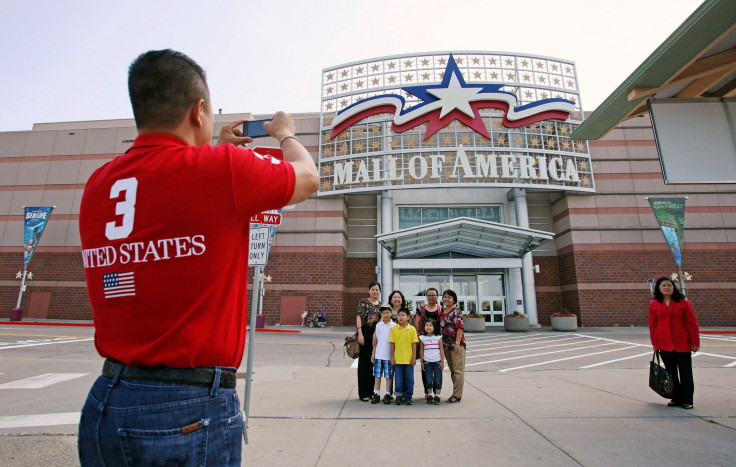Mall Of America Attack Threat: Al Shabab Warning Raises Fears Of Lone Wolf Attacks On US Malls

Malls around the United States are boosting security following the Somali militant group al- Shabab’s threats Sunday against shopping centers in the West. But as successful as security agencies in the U.S. have been at preventing mass attacks since Sept. 11, 2001, counterterrorism experts are nonetheless warning of the vulnerability of public spaces like malls in the face of the increasing threat of lone wolf-style violence.
While a Homeland Security Department official said there was “no credible” evidence suggesting an attack was imminent, enhanced security measures are now in place at the Mall of America in Minnesota, which al-Shabab specifically mentioned. The department said Monday that it was not aware of any specific plots against the mall, which is the largest U.S. shopping center with an estimated 40 million visitors annually, and called the threat propaganda. Federal, state and local law enforcement agencies continued to monitor information around the group’s threat, said a statement from the local Bloomington Police Department.
From a security standpoint, malls are seen as easy targets because of their design, said Patrick Skinner, director of special projects at the Soufan Group in New York and a former CIA case officer specializing in counterterrorism. “Malls are a nightmare to defend because they’re designed to maximize entry and egress,” he said. “Malls are not designed like prisons or forts because they want people to come in easily to shop.”
Al-Shabab, responsible for the September 2013 attacks on the Westgate Mall in Nairobi, Kenya, that left more than 60 people dead, called for attacks on Western shopping malls in a video that surfaced Sunday. In the nearly 80-minute video posted online, a masked man wearing a camouflage jacket declared: “Westgate was just the beginning.” The video also included footage depicting al-Shabab’s 2013 mall assault and said it was in revenge for abuses by Kenyan troops against Somali Muslims. In addition to threatening the Mall of America, the videotaped message also specifically mentioned the West Edmonton Mall in Canada and London’s Oxford Street, Reuters reported.
Other malls around the U.S. were also on alert Monday, with the International Council of Shopping Centers, one of the country’s largest trade association of malls, saying individual members were working with law enforcement to “refine their security plans,” according to a statement issued by the organization Monday. The Westfield Corp., which operates one of the largest network of shopping centers around the world, also said it would be taking “every available step” to keep its shoppers safe. Among the corporation's holdings are the Westfield Garden State Plaza in New Jersey, which is one of the largest malls in the U.S.
Mass attacks by organized militant groups have been the focus of largely successful U.S. counterterrorism efforts over the past decade, but stores and shopping centers are still vulnerable to so-called “lone wolf” attacks, as seen recently in Paris and Copenhagen, said Skinner, who pointed out that a few gunmen managed to bring Paris to a standstill during the January attacks on satirical magazine Charlie Hebdo and a kosher supermarket that left 17 people dead. “You don't need to be a highly trained Navy SEAL to walk into a mall and cause havoc,” he said. “Remember, they're not attacking a military base, they're attacking the Gap.”
Law enforcement organizations have studied attacks like al-Shabab’s Westgate assault in Nairobi to better predict future scenarios, said Christopher Voss, CEO of the U.S.-based Black Swan consulting group and a 24-year veteran of the FBI. “In any public place, there’s a certain amount of vulnerability, but a lone-wolf threat is extremely difficult to stop,” he said. However, "in this day and age public security directors are keenly aware of these possibilities.”
Among the red flags that law enforcement agencies look out for are people possibly preparing for an attack. “Terrorists don't just randomly pick a mall out on a map and carry out an attack. They don't like to be surprised by the layout, so they visit it in advance and plan out the attack,” Skinner said. “Typically they often walk through it and rehearse. Security in public places is really keyed on people who look like they are preparing for an attack.”
As much concern as there is about the possibility of a lone-wolf attack on public spaces like malls, some experts question the probability of such an attack by al-Shabab. “Obviously there are Somali communities in the Mall of the Americas area that in theory could have an al-Shabab sympathizer or two among them, which would make it easier for them to know and access this mall,” said Michael O'Hanlon, co-director of the Center for 21st Century Security and Intelligence at the Brookings Institute in Washington, D.C. However, the fact that the Somali militant group chose to publicize its warning “smacks of bluffing,” he said. “They prefer a surprise, an ambush, partly because it increases the casualties and partly because it increases the shock value and therefore the terroristic effect.”
Minnesota’s Somali community, which is thought to be the largest in the U.S. with an estimated 32,000 members, has no history of committing such violent acts, according to Skinner. He speculated that al-Shabab may be trying to energize Somali-Americans in the area to carry out the attack as a means of “out-sourcing or crowd-sourcing” their terror strategy.
Al-Shabab’s own capability of committing such an attack on foreign soil is also questionable, said Voss. “Al-Shabab feels like they're losing their relevance because ISIS is getting all the headlines, and terrorist groups are jealous of publicity other terror groups get,” he said. “This is just a cheap way to get publicity.”
© Copyright IBTimes 2024. All rights reserved.





















